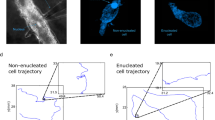Summary
The locomotion ofAmoeba proteus has been investigated by algorithms evaluating correlation dimension and Lyapunov spectrum developed in the field of nonlinear science. It is presumed by these parameters whether the random behavior of the system is stochastic or deterministic. For the analysis of the nonlinear parameters, n-dimensional time-delayed vectors have been reconstructed from a time series of periphery and area ofA. proteus images captured with a charge-coupled-device camera, which characterize its random motion. The correlation dimension analyzed has shown the random motion ofA. proteus is subjected only to 3–4 macrovariables, though the system is a complex system composed of many degrees of freedom. Furthermore, the analysis of the Lyapunov spectrum has shown its largest exponent takes positive values. These results indicate the random behavior ofA. proteus is chaotic and deterministic motion on an attractor with low dimension. It may be important for the elucidation of the cell locomotion to take account of nonlinear interactions among a small number of dynamics such as the sol-gel transformation, the cytoplasmic streaming, and the relating chemical reaction occurring in the cell.
Similar content being viewed by others
References
Allen RD, Francis D, Zeh R (1971) Direct test of the positive pressure gradient theory of pseudopod extension and retraction in Amoebae. Science 174:1237–240
Babloyants A, Destexhe A (1986) Low-dimensional chaos in an instance of epilepsy. Proc Natl Acad Sci USA 83: 3513–3517
— Salazer JM (1985) Evidence of chaotic dynamics of brain activity during the sleep cycle. Phys Lett 111 A: 152–156
Cunningham CC, Stossel TP, Kwiatkowski DJ (1991) Enhanced motility in NIH 3T3 fibroblasts that overexpress gelsolin. Science 251:1233–1236
Essex C, Lookman T, Nerenberg MAH (1987) The climate attractor over short timescales. Nature 326: 64–66
Fukui Y (1993) Toward a new concept of cell motility: cytoskeletal dynamics in amoeboid movement and cell division. Int Rev Cytol 144: 85–127
— Lynch TJ, Brzesca H, Korn ED (1989) Myosin I is located at the leading edges of locomoting Dictyostelium amoebae. Nature 341: 328–331
Gaulitta W, Stockem W (1980) Organization and arrangement of fluorescein-labeled native actin microinjected into normal locomoting and experimentally influencedAmoeba proteus. Cell Tissue Res 206:181–191
Grassberger P, Procaccia I (1983) Characterization of strange attractors. Phys Rev Lett 31: 346–349
Harris AS, Morrow JS (1990) Calmodulin and calcium-dependent protease I coordinately regulate the interaction of fodrin with actin. Proc Natl Acad Sci USA 87: 3009–3013
John THM, Ghosh RN, Maxfield FR (1995) Intracellular calcium levels correlate with speed and persistent forward motion in migrating neutrophils. Biophys J 68:1207–1217
Killich T, Plath PJ, Xiang W, Bultmann H, Rensing L, Vicker MG (1993) The locomotion, shape and pseudopodial dynamics of unstimulatedDictyostelium cells are not random. J Cell Sci 106: 1005–1013
Korohoda W, Golda J, Sroka J, Wojnarowicz A, Jochym P, Madeja Z (1997) Chemotaxis ofAmoeba proteus in the developing pH gradient within a pocket-like chamber studied with the computer assisted method. Cell Motil Cytoskeleton 38: 38–53
Lorenz EN (1963) Deterministic nonperiodic flow. J Atmos Sci 20: 130–141
Mattfeldt T (1997) Nonlinear deterministic analysis of tissue texture: a stereological study on mastopathic and mammary cancer tissue using chaos theory. J Micros 185: 47–66
Peterson SC, Noble PB (1972) A two-dimensional random walk analysis of human granulocyte movement. Biophys J 12: 1048–1055
Nicolis G, Prigogine I (1977) Self-organization in nonequilibrium systems. Wiley, London
Potel MJ, McKay SA (1979) Preaggregative cell motion inDictyostelium. J Cell Sci 36:281–309
Rosenstein MT, Collins JJ, DeLuca CJ (1994) Reconstruction expansion as a geometry-based framework for choosing proper delay times. Physica D 73: 82–98
Sano M, Sawada Y (1985) Measurement of the Lyapunov spectrum from a chaotic time series. Phys Rev Lett 55:1082–1085
Sato S, Sano M, Sawada Y (1987) Practical methods of measuring the generalized dimension and the largest Lyapunov exponent in high dimensional chaotic systems. Prog Theor Phys 77:1–5
Satoh H, Ueda T, Kobatake Y (1985) Oscillations in cell shape and size during locomotion and in contractile activities ofPhysarum polycephalum, Dictyostelium discoideum, Amoeba proteus and macrophages. Exp Cell Res 156:79–90
Shimada I, Nagashima T (1979) A numerical approach to ergodic problem of dissipative dynamical systems. Prog Theor Phys 61: 1605–1616
Singer SJ, Kupfer A (1986) The directed migration of eukaryotic cells. Annu Rev Cell Biol 2: 337–365
Stockem W, Hoffmann HU, Wolfgang G (1982) Spatial organization and fine structure of the cortical filament layer in normal locomotingAmoeba proteus. Cell Tissue Res 221: 505–519
Takens F (1981) Detecting strange attractors in turbulence. Lecture Notes Math 898: 366–381
Tatsuka M, Jinno S, Owada MK, Kakunaga T (1989) A digital image processing system for quantitating dynamic morphology in cultured mammalian cells. Exp Cell Res 185: 342–352
Taylor DL, Moore PL, Condeelis JS, Allen RD (1976) The mechanical basis of amoeboid movement I: ionic requirements for maintaining viscoelasticity and contractility of amoeba cytoplasm. Exp Cell Res 101:127–133
Ueda T, Kobatake Y (1983) Quantitative analysis of changes in cell shape ofAmoeba proteus during locomotion and upon responses to salt stimuli. Exp Cell Res 147:466–472
Wagner CD, Persson PB (1995) Nonlinear chaotic dynamics of arterial blood pressure and renal blood flow. Am J Physiol 268: H621-H627
Wolf A, Swift JB, Swinney HL, Vastano JA (1985) Deterministic Lyapunov exponents from a time series. Physica D 16: 285–317
Author information
Authors and Affiliations
Rights and permissions
About this article
Cite this article
Miyoshi, H., Kagawa, Y. & Tsuchiya, Y. Chaotic behavior in the locomotion ofamoeba proteus . Protoplasma 216, 66–70 (2001). https://doi.org/10.1007/BF02680132
Received:
Accepted:
Issue Date:
DOI: https://doi.org/10.1007/BF02680132



